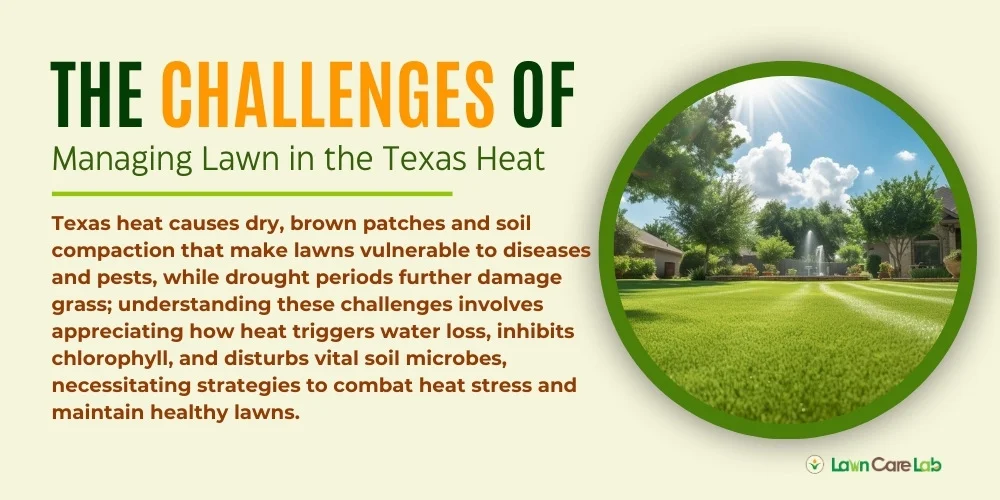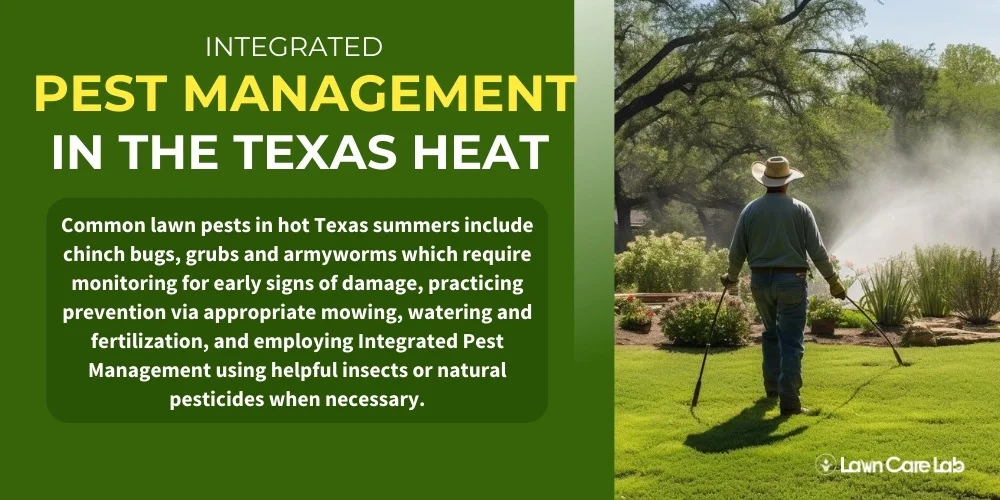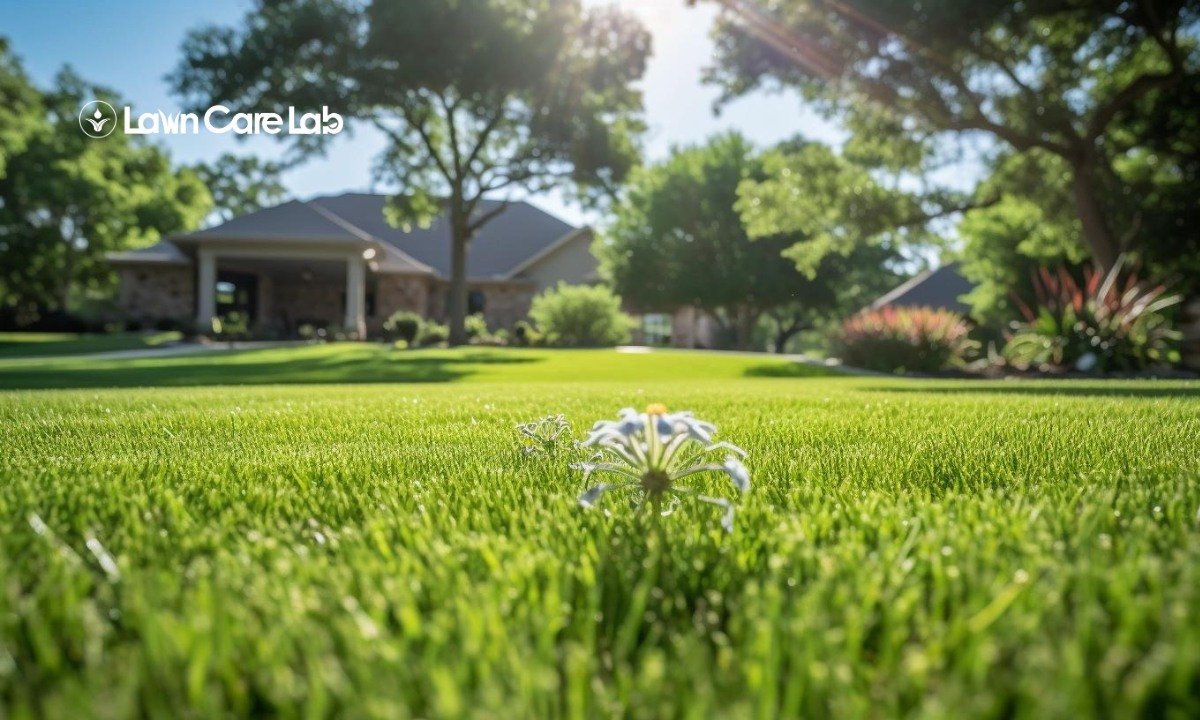The relentless Texas sun has got you worried about your lawn, right? Fear not! This guide is your friend in need, offering practical advice on effectively maintaining your green space even in the harshest of summers.
Our aim? Help you understand Texas’s unique climate challenges, learn essential lawn care techniques, and more.
So, are you ready to wear those gardening gloves and stand tall against the elements? Let’s do this together because your lawn’s well-being and peace of mind are worth the sweat and toil.
Table of Contents
Understanding the Challenges of Managing Lawn in the Texas Heat

Maintaining a healthy lawn in Texas can be tough due to scorching temperatures exceeding 100 degrees and periods of drought that can damage your grass.
Understanding how these harsh conditions can result in dry, brown patches and a general decline in your lawn’s health is a key part of managing your outdoor space effectively.
How Texas Heat Impacts Lawn Health
Texas heat causes dry and brown lawn patches, leading to soil compaction that obstructs root and nutrient growth. This creates a ripple effect, making lawns more vulnerable to diseases and pests.
A healthy lawn looks good, reduces soil erosion, and provides oxygen. Maintaining it in extreme Texas heat is an environmental responsibility.
As one garden expert aptly puts it, ‘A healthy lawn is more than just a luxury; it’s a necessity for our environment, especially in the face of extreme weather conditions.’
The Science Behind Heat Stress on Lawns
Given the intense heat in Texas, it’s important to comprehend the science at play when your lawn faces heat stress. This condition can turn your lush, green grass into a drab, lifeless brown.
Effects of Heat Stress on your lawn:
- Triggers water loss
- Inhibits chlorophyll production, leading to color loss
- Disturbs soil microbes, upsetting nutrient cycling and disease prevention
Recognizing and developing strategies to combat heat stress is crucial for maintaining a healthy lawn in Texas.
Essential Lawn Care Strategies for the Texas Heat

Understanding your grass and practicing smart watering habits are key to maintaining a lush, green lawn in the intense Texas heat.
Choosing resilient grass varieties in high temperatures is a strategic approach, as these species are designed to withstand the sweltering climate.
Just as vital is the art of watering your lawn. It’s not just about drenching your grass but ensuring it’s sufficiently hydrated without water wastage.
Watering Techniques for Optimal Hydration
Understanding the right watering pattern for your Texas lawn during the hot summer months is key to keeping it healthy and vibrant. Correct watering allows your lawn to remain green and robust, even in extreme heat.
Let’s break down the optimal timing for watering and the precise amount of hydration your lawn requires.
Best Time to Water Your Lawn and How Much Water Does Your Lawn Need
Maintaining a lush and healthy lawn in the blazing Texas heat requires more than occasional watering. You need to pay attention to the timing and volume of watering to ensure the grass gets the nourishment it needs.
Here’s what you need to remember:
- Ideal Watering Time: The best time to water your lawn is in the early morning when evaporation levels are low.
- Volume of Water: As a general guideline, aim to provide your lawn with 1 to 1.5 inches of water per week.
- Changes: Remember the type of grass, the nature of the soil, and the weather conditions to adjust your watering routine accordingly.
These simple yet effective tips will help you keep your lawn looking fresh and vibrant, even in the Texas summer heat. As the saying goes, ‘A well-watered lawn is a happy lawn!’
Choosing Heat-Tolerant Grass Varieties
Making a conscious decision to go for heat-resistant grass types for your lawn is a practical approach, especially if you live in a hot place like Texas. An assortment of these grass types is available, each needing a unique set of care practices.
How to Maintain Different Grass Varieties
As you wisely opt for grass types that can withstand Texas’s heat, it’s worth noting that each variety has its own set of maintenance needs for the best health and growth.
Here’s a look at some common grass types and their care requirements:
Bermuda Grass:
- Water: Ideally, once a week
- Mow: Keep it between 1-2 inches in height
- Fertilize: Best done in spring
Zoysia Grass:
- Water: Roughly every 10 days
- Mow: Aim for a height of 2-3 inches
- Fertilize: Early summer is the best time
St. Augustine Grass:
- Water: Twice a week watering is recommended
- Mow: Maintain at a height of 2.5-3 inches
- Fertilize: Late spring is the optimal time
Remember, every grass type has unique needs, and understanding them can make all the difference in achieving a lush, vibrant lawn.
Fertilizing and Soil Management in the Texas Heat
To maintain a healthy lawn in Texas, conduct a soil test to determine nutrient needs and choose a suitable fertilizer. This is especially important in hot environments like Texas due to climate change.
Proper soil management and fertilizer use are essential for a green and healthy environment.
Importance of Soil Testing
Soil testing is crucial for managing your lawn in the Texas heat. It helps you understand the nutrient levels, pH balance, and organic matter content in the soil, allowing you to make evidence-based decisions about fertilization and soil management.
Knowing the ins and outs of your soil’s composition leads to a healthier and more resilient lawn, even in harsh weather conditions. Get a soil test today and ensure your lawn stays lush and vibrant.
How to Conduct a Soil Test
Keeping your Texas lawn thriving in the intense heat starts with understanding your soil’s specific needs. Conducting a soil test is the way to gain that understanding.
Here’s a simple guide to help you:
- Start by buying a soil test kit.
- You can find these kits at local garden centers or online stores.
- Gather samples from various parts of your lawn to ensure a comprehensive understanding.
- Once collected, these samples need to be sent for analysis.
- Conveniently, most kits come with a prepaid envelope for this purpose.
Interpreting Soil Test Results
Reading the soil test results correctly is important to manage your Texas lawn efficiently. Look for pH, nutrients, and organic matter content to determine the best fertilizer and maintain a healthy lawn.
Understanding your soil test results empowers you to make the best decisions for your lawn.
Selecting the Right Fertilizer for Your Lawn
Choosing the perfect fertilizer for your lawn can be complex in the Texas heat. Understanding your soil’s nutrient profile is crucial, and determining which nutrients your grass needs the most is crucial.
Is it a fertilizer rich in nitrogen or one that focuses on potassium? Making the right choice can significantly impact the health and growth of your lawn.
Fertilizing Schedule for Texas Lawns
Knowing how to fertilize your Texas lawn in the face of intense heat is crucial for maintaining soil health and promoting growth. Here are some useful guidelines:
- Begin fertilization when you notice the grass starting to sprout in the spring.
- A second round of fertilization in the fall ensures your lawn is ready for winter.
- Adhering to the fertilizing schedule for your specific type of grass is vital.
Integrated Pest Management in the Texas Heat

Managing pests in Texas lawns during hot summers can be challenging. Regular monitoring, preventive measures, and wise use of pesticides can help maintain a healthy lawn.
Common Lawn Pests in Texas
In the scorching Texas sun, your lawn is constantly assaulted by pests such as chinchbugs, grubs, and armyworms. Recognizing these nuisances and acting swiftly is necessary to stop them from ruining your lush green patch.
Identifying Lawn Pests
Catching early signs of damage in your lawn can be your best bet against typical pests in Texas, like the heat-loving chinch bugs or the drought-resistant armyworms.
Visually spotting pests:
- Employ a magnifying glass for the tiny critters.
- Be on the lookout for brown patches that could signify damage.
Adopt Integrated Pest Management:
- Get familiar with the pests’ behaviors.
- Opt for treatments that are both safe and effective.
Keeping your lawn safe is of utmost importance, which means accurately identifying and controlling these pests.
Natural Pest Control Methods
Identify lawn pests and use natural pest control methods for Integrated Pest Management in harsh Texas climate.
A good practice is to welcome helpful insects such as ladybugs and lacewings into your garden. They can play a significant role in controlling the pest population.
It’s also a good idea to use natural pesticides like neem oil. It’s a safe and effective way to handle pests.
Preventive Measures Against Lawn Pests
In hot Texas, prevent pest damage by nurturing a healthy lawn and watching for pest activity.
Let’s break this down:
On the Path to a Healthy Lawn: The stronger your lawn, the less inviting it is for pests.
- Mindful Mowing: Keep your grass at a reasonable height. Cutting it too short can stress the plant, making it an easy target for pests.
- Smart Watering: Opt for infrequent, deep watering to encourage deeper roots and drought resistance.
Keep an Eye Out for Pests: Early detection can mean the difference between a small problem and a full-blown infestation.
- Signs of Trouble: Watch out for areas of discoloration or chewed-up leaves, as these could indicate pest presence.
Strike a Balance with Water and Fertilizer: Overdoing these can actually invite pests. It’s all about finding the right balance to keep your lawn thriving.
A healthy lawn and early pest detection can save you from future troubles. Remember to prioritize defense in lawn care.
Conclusion
Managing your lawn in the hot Texas weather may seem challenging, but it’s doable. You must understand the climate, use the right lawn care methods, maintain soil health, use fertilizers, and control pests.
The resulting lawn will be vibrant and healthy, able to withstand the harsh Texas weather. The secret? Adjusting to the circumstances. You’ll have the most verdant lawn in your neighborhood with the correct tactics.
‘Adapting isn’t just surviving, it’s thriving. And with the right strategies, your lawn can thrive too, even in the Texas heat.’
- How to Create a Lawn Care Schedule for Southern Climates - October 30, 2024
- How to Use Compost Tea to Boost Lawn Growth and Soil Health - October 23, 2024
- The Best Grasses for Saltwater-Exposed Lawns: Coastal Lawn Care - October 17, 2024




